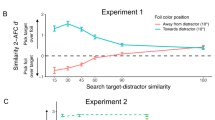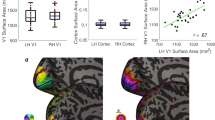Abstract
Shifting attention away from a visual stimulus reduces, but does not abolish, visual discrimination performance. This residual vision with 'poor' attention can be compared to normal vision with 'full' attention to reveal how attention alters visual perception. We report large differences between residual and normal visual thresholds for discriminating the orientation or spatial frequency of simple patterns, and smaller differences for discriminating contrast. A computational model, in which attention activates a winner-take-all competition among overlapping visual filters, quantitatively accounts for all observations. Our model predicts that the effects of attention on visual cortical neurons include increased contrast gain as well as sharper tuning to orientation and spatial frequency.
This is a preview of subscription content, access via your institution
Access options
Subscribe to this journal
Receive 12 print issues and online access
$209.00 per year
only $17.42 per issue
Buy this article
- Purchase on Springer Link
- Instant access to full article PDF
Prices may be subject to local taxes which are calculated during checkout






Similar content being viewed by others
References
Pashler, H. The Psychology of Attention (MIT Press, Cambridge, Massachusetts, 1997).
Mueller, H. J. & Findlay, J. M. Sensitivity and criterion effects in the spatial cueing of visual attention. Percept. Psychophys. 42, 383–399 (1987).
Treisman, A. & Gormican, S. Feature analysis in early vision: evidence from search asymmetries. Psychol. Rev. 12, 97–136 (1988).
Braun, J. & Julesz, B. Withdrawing attention at little or no cost: Detection and discrimination tasks. Percept. Psychophys. 60, 1–23 (1998).
Lee, D. K., Koch, C. & Braun, J. Spatial vision thresholds in the near absence of attention. Vision Res. 37, 2409–2418 (1997).
Nachmias, J. & Sansbury, R. V. Letter: Grating contrast: discrimination may be better than detection. Vision Res. 14, 1039–1042 (1974).
Wilson, H. R. A transducer function for threshold and suprathreshold human vision. Biol. Cybern. 38, 171–178 (1980).
Legge, G. E. & Foley, J. M. Contrast masking in human vision. J. Opt. Soc. Am. 70, 1458– 1471 (1980).
Bowne, S. F. Contrast discrimination cannot explain spatial frequency, orientation or temporal frequency discrimination. Vision Res. 30, 449–461 (1990).
Wilson, H. R. & Wilkinson, F. Evolving concepts of spatial channels in vision: from independence to nonlinear interactions. Perception 26, 939–960 (1997).
Wilson, H. R. & Humanski, R. Spatial frequency adaptation and contrast gain control. Vision Res. 33, 1133–1149 (1993).
Foley, J. M. Human luminance pattern-vision mechanisms: masking experiments require a new model. J. Opt. Soc. Am. 11, 1710– 1719 (1994).
Zenger, B. & Sagi, D. Isolating excitatory and inhibitory nonlinear spatial interactions involved in contrast detection. Vision Res. 36, 2497–2513 (1996).
Carandini, M. & Heeger, D. J. Summation and division by neurons in primate visual cortex. Science 264, 1333–1336 (1994).
Itti, L., Braun, J., Lee, D. K. & Koch, C. in Advances in Neural Information Processing Systems, Vol. 9 (eds. Mozer, M. C., Jordan, M. I. & Petsche, T.) 173–179 (MIT Press, Cambridge, Massachusetts, 1997).
Somers, D. C., Nelson, S. B. & Sur, M. An emergent model of orientation selectivity in cat visual cortical simple cells. J. Neurosci. 15, 5448–5465 (1995).
Carandini, M., Heeger, D. J. & Movshon, J. A. Linearity and normalization in simple cells of the macaque primary visual cortex. J. Neurosci. 17, 8621–8644 (1997).
Braun, J. & Sagi, D. Vision outside the focus of attention. Percept. Psychophys. 48, 45– 58 (1990).
Braun, J. Visual search among items of different salience: removal of visual attention mimics a lesion in extrastriate area V4. J. Neurosci. 14, 554–567 (1994).
Palmer, J. Attention in visual search: distinguishing four causes of set-size effects. Curr. Dir. Psychol. Sci. 4, 118– 123 (1995).
Solomon, J. A., Lavie, N. & Morgan, M. J. Contrast discrimination function: spatial cuing effects. J. Opt. Soc. Am. 14, 2443– 2448 (1997).
Foley, J. M. & Schwarz, W. Spatial attention: effect of position uncertainty and number of distractor patterns on the threshold-versus-contrast function for contrast discrimination. J. Opt. Soc. Am. 15, 1036–1046 (1998).
DeValois, R. L. & DeValois, K. K. Spatial Vision (Oxford Univ. Press, New York, 1988).
Wilson, H. R., Levi, D., Maffei, L., Rovamo, J. & DeValois, R. in Visual Perception: The Neurophysiological Foundations (eds. Spillmann, L. & Werner, J. S.) 231– 272 (Academic, San Diego, California, 1990).
Geisler, W. S. & Albrecht, D. G. Visual cortex neurons in monkeys and cats: detection, discrimination, and identification. Vis. Neurosci. 14, 897– 919 (1997).
Bonnel, A.-M. & Miller, J. Attentional effects on concurrent psychophysical discriminations: investigations of a sample size model. Percept. Psychophys. 55, 162–179 (1994).
Lu, Z. L. & Dosher, B. A. External noise distinguishes attention mechanisms. Vision Res. 38, 1183– 1198 (1998).
Morgan, M. J., Ward, R. M. & Castet, E. Visual search for a tilted target: tests of spatial uncertainty models. Q. J. Exp. Psychol. 51, 347–370 (1998).
Yeshurun, Y. & Carrasco, M. Spatial attention improves performance in spatial resolution task. Vision Res. 39, 293–305 (1999).
Moran, J. & Desimone, R. Selective attention gates visual processing in the extrastriate cortex. Science 229, 782–784 (1985).
Motter, B. C. Focal attention produces spatially selective processing in visual cortical areas V1, V2, and V4 in the presence of competing stimuli. J. Neurophysiol. 70, 909–919 (1993).
Treue, S. & Maunsell, J. H. Attentional modulation of visual motion processing in cortical areas MT and MST. Nature 382, 539–541 (1996).
Luck, S. J., Chelazzi, L., Hillyard, S. A. & Desimone, R. Neural mechanisms of spatial selective attention in areas V1, V2, and V4 of macaque visual cortex. J. Neurophysiol. 77, 24–42 (1997).
Roelfsema, P. R., Lamme, V. A. & Spekreijse, H. Object-based attention in the primary visual cortex of the macaque monkey. Nature 395, 376– 381 (1998).
Brefczynski, J. A. & DeYoe, E. A. A physiological correlate of the 'spotlight' of visual attention. Nat. Neurosci. 2, 370–374 (1999).
Niebur, E. & Koch, C. A model for the neuronal implementation of selective visual attention based on temporal correlation among neurons. J. Comput. Neurosci. 1, 141– 158 (1994).
Tsotsos, J. K. et al. Modeling visual attention via selective tuning. Artif. Intell. 78, 507–547 (1995).
Desimone, R. Visual attention mediated by biased competition in extrastriate visual cortex. Phil. Trans. R. Soc. Lond. B 353, 1245– 1255 (1998).
McAdams, C. J. & Maunsell, J. H. R. Effects of attention on orientation-tuning functions of single neurons in macaque cortical area V4. J. Neurosci. 19, 431– 441 (1999).
Spitzer, H., Desimone, R. & Moran, J. Increased attention enhances both behavioral and neuronal performance. Science 240, 338– 340 (1988).
Tyler, C. W. Colour bit-stealing to enhance the luminance resolution of digital displays on a single pixel basis. Spatial Vis. 10, 369–377 (1997).
Duncan, J. Selective attention and the organization of visual information. J. Exp. Psychol Gen. 113, 501–517 (1984).
Pashler, H. Dual-task interference in simple tasks - Data and theory. Psychology B 116, 220–244 (1994).
Dosher, B. A. & Sperling, G. in Handbook of Perception and Cognition, Perception and Cognition at Century's End: History, Philosophy, Theory (ed. Hochberg, J.) 201–254 (Academic, New York, 1998).
Duncan, J., Ward, R. & Shapiro, K. Direct measurement of attentional dwell time in human vision. Nature 369, 313– 315 (1994).
Braun, J. Vision and attention: the role of training. Nature 393, 424–425 (1998).
Lee, D. K., Koch, C. & Braun, J. Visual attention is undifferentiated: concurrent discrimination of form, color, and motion. Percept. Psychophys. 61 (in press).
Seung, H. S. & Sompolinsky, H. Simple models for reading neuronal population codes. Proc. Natl. Acad. Sci. USA 90, 10749–10753 (1993).
Pouget, A., Zhang, K., Deneve, S. & Latham, P. E. Statistically efficient estimation using population coding. Neural Comput. 10, 373–401 (1998).
Press, W. H., Teukolsky, S. A., Vetterling, W. T. & Flannery, B. P. Numerical Recipes in C, 2nd ed. (Cambridge Univ. Press, Cambridge, 1992).
Acknowledgements
Supported by NSF, NIMH, ONR and the NSF-ERC at Caltech. We thank T. Albright and T. Sejnowski for access to facilities and J. Gallant, A. Manwani, S. Shimojo, K. Watanabe and B. Zenger for comments and discussions.
Author information
Authors and Affiliations
Corresponding author
Rights and permissions
About this article
Cite this article
Lee, D., Itti, L., Koch, C. et al. Attention activates winner-take-all competition among visual filters . Nat Neurosci 2, 375–381 (1999). https://doi.org/10.1038/7286
Received:
Accepted:
Issue Date:
DOI: https://doi.org/10.1038/7286
This article is cited by
-
Sleep-like unsupervised replay reduces catastrophic forgetting in artificial neural networks
Nature Communications (2022)
-
Spatial attention in perceptual decision making as revealed by response-locked classification image analysis
Scientific Reports (2022)
-
The human endogenous attentional control network includes a ventro-temporal cortical node
Nature Communications (2021)
-
Time-dependent inhibition of covert shifts of attention
Experimental Brain Research (2021)
-
A model of co-saliency based audio attention
Multimedia Tools and Applications (2020)



